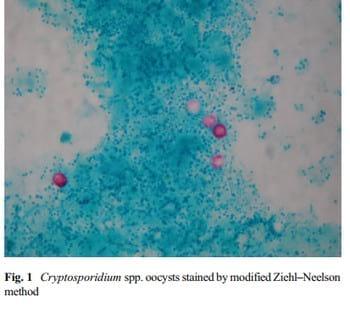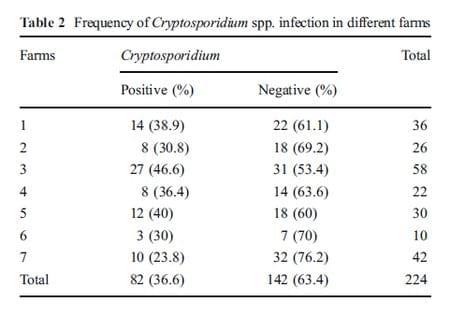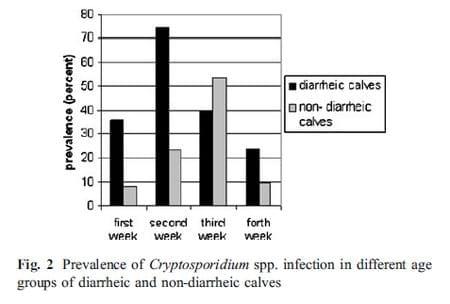Cryptosporidium is a protozoan genus that belongs to the phylum Apicomplexa, class Sporozoasida, subclass Coccidiasina, order Eucoccidiorida, suborder Eimeriorina and family Cryptosporidiidae (Sterling and Arrowood 1993). This parasite has been detected in a wide range of vertebrate hosts. Infection, which usually causes selflimiting diarrhea in human and animals, can be fatal in immunocompromised individuals (O’Donoghue 1995; Fayer et al. 1997; Caccio and Pozio 2006). This parasite causes significant neonatal morbidity in cattle, causing weight loss and delayed growth, which leads to large economic losses (Xiao et al. 1999; McDonald 2000). Infection in cattle is highly age-dependent. Young calves show the highest prevalence of infection and shed the organism with highest intensity (Garber et al. 1994; Quilez et al. 1996).
In particular, cattle are infected with at least four Cryptosporidium species, including Cryptosporidium parvum, Cryptosporidium bovis, Cryptosporidium andersoni, and the Cryptosporidium deer-like genotype (Fayer et al. 2006; Feng et al. 2007); however, pre-weaned calves have been reported to be predominantly infected with the zoonotic species, C. parvum. The infection with this species in postweaned calves and older animals is almost completely replaced with C. andersoni, C. bovis, and the deer-like genotype (Santín et al. 2004; Fayer et al. 2006; Thompson et al. 2007).
C. parvum has been incriminated as an important cause of neonatal diarrhea in calves and most often affects calves under 1 month of age. The affected calves may shed large numbers of infective oocysts in the feces (Nydam et al. 2001). Cryptosporidium infection of calves may be asymptomatic or causes clinical signs ranging from mild intermittent diarrhea to profuse watery diarrhea withconcomitant dehydration (Fayer and Ungar 1986). Clinical symptoms depend on the parasite species involved and specific host characteristics, such as age and immunological state (Xiao et al. 2004).
The zoonotic potential of infection with Cryptosporidium has been largely studied. Genotyping of the parasite has shown that human and other animals can be infected with the same species of Cryptosporidium (Monis and Thompson 2003). Calves are an important source of human cryptosporidial infections (Olson et al. 1997).
Since there was no documented information on the status of cryptosporidial infection and its association with diarrhea among newborn calves in dairy farms around Mashhad (Iran), we devised a matched case-control study to investigate the relationship between diarrhea and excretion of Cryptosporidium spp. oocyst in feces and also to determine the prevalence of Cryptosporidium infection in newborn calves with diarrhea in the area.
Materials and Methods
The study was performed in the Northeast region of Iran, in the area of Mashhad, the capital city of the Khorasan Razavi province. The city is located at 36.20° latitude and 59.35° East longitude, in the valley of the Kashaf River near Turkmenistan, between the two mountain ranges of Binalood and Hezar-masjed. The city benefits from the proximity of the mountains, having very cold winters and pleasant springs. Mashhad has more than 500 dairy farms with an estimated 70,000 cows of mostly Holstein/Friesian breed. In the present study, seven industrial dairy herds were selected. We carried out a cross-sectional study, with a random cluster sampling design, from May 2008 to October 2008 (Table 1). The cow breed in all these farms was Holstein/Friesian. In all farms, calves were separated from their dams after they received colostrum and were housed in individual pens until weaning at 3 months of age.
Sampling technique
All farms were visited weekly and fecal samples were collected. Upon each visit, all calves under 1 month of age with signs of diarrhea were sampled, provided that they had not received prior treatment with antibiotics. Fecal consistency was scored on a 4-point scale as described by Larson et al (1977). For this study, a score of 3 or 4 indicated the presence, and a score of 1 or 2 the absence of diarrhea.

For each case calf, a corresponding calf with normal feces (with a fecal score of 1 or 2), closest in age (with a maximum age difference of 4 days) on the same farm was sampled as control. Whenever an animal was sampled, a form was completed with related information. Sample size was calculated as the minimum number of calves necessary to detect a difference between 36.66% (prevalence rate of Cryptosporidium in calves with diarrhea; Radfar et al. 2006) and 19.92% (prevalence rate of Cryptosporidium in calves without diarrhea; Radfar et al. 2006) at a confidence level of 95% and a power of 80% (Thrusfield 2005); 105 calves with diarrhea and 105 controls were needed. We sampled 112 pairs of calves, each pair consisting of a diarrheic calf and a non-diarrheic calf.
Controls were discarded whenever they turned into cases within 1 week of sampling and, consequently, the match was not used in the analysis. Fecal samples were collected directly from the rectum by stimulating the anus with fingers. All samples were transported on ice to the parasitology laboratory of the School of Veterinary Medicine of Ferdowsi University of Mashhad on the same day. Samples were stored at 4°C until processing.
Parasitological examination
Moderately thick fecal smears were prepared and air-dried. After fixation by methanol, the fecal smears were stained by modified Ziehl–Neelson staining. The stained smears were observed under microscope with a ×400 to ×1,000 magnification. The Cryptosporidium spp. oocysts were visualized as bright red round bodies against a pale green background, containing elongated naked sporozoites (Fig. 1). Cryptosporidium infection was scored positive or negative based on the presence or absence of the oocyst in examined microscopical fields in each sample.
A sample was considered positive for Cryptosporidium spp. if an oocyst was detected with the correct morphology, i.e., optical properties, internal structure, size, and shape as described by Fayer (1997).
Statistical analysis
The McNemar test was used to analyze these 1:1 individually matched case-control data and to estimate the associations between diarrhea and the presence of Cryptosporidium spp. oocysts in fecal samples. Data were analyzed with SAS statistical software (Version 9.1) and P values less than .05 were considered to be statistically significant.
Results
Descriptive statistics
Fecal samples were collected from112 pairs of calves; in each pair, one calf was diarrheic and another one was non-diarrheic.
In all farms, there were calves that shed Cryptosporidium spp. in their feces (Table 2). The average age of a scouring calf was 13.08 days (median 11 days with a range of 1 to 30 days) and for control animals, 13.58 days (median 12 with a range of 2 to 30 days). Among all animals sampled, 82 calves were positive. Cryptosporidium infection was detected in 58 out of 112 (51.8%) diarrheic and 24 (21.4%) out of 112 non-diarrheic calves. Distribution of matched pairs (each pair consists of a case and a control) in different age groups of newborn calves is shown in Table 3. Cryptosporidium infection was detected in nine out of 25 (36%), 38 out of 51 (74.5%), six out of 15 (40%), and five out of 21(23.8%) of 112 diarrheic animals in age groups 1–7, 8–14, 15–21, and 22–30 days old, respectively.

Therefore, the highest risk of being infected with Cryptosporidium spp. in diarrheic calves occurred in the second week of life. Among non-diarrheic calves, Cryptosporidium infection was detected in 8%, 23.5%, 53.3%, and 9.5% in age groups 1–7, 8–14, 15–21, and 22–30 days old, respectively (Fig. 2).
Analytical statistics
Comparison between non-scouring and scouring calves using the McNemar test in all sampled calves showed significant differences in odds ratio for the presence of Cryptosporidium spp. in fecal samples. The excretion of parasite in the feces of diarrheic calves was significantly higher (odds ratio 6.1) than in healthy calves (Table 3). Differences between animals with and without diarrhea were statistically significant for age groups 1–7 and also 8– 14 day-old calves and odds ratios were 8 and 15, respectively (Table 3).
Discussion
In the present study, infection with Cryptosporidium spp. in neonatal calves was prevalent and was also associated with clinical diarrhea. The detection rate of Cryptosporidium spp. in newborn diarrheic calves in this study (51.8%) is higher than those found in neonatal diarrheic calves in other parts of Iran (Radfar et al. 2006) and also in other countries (from 14.1% to 44.4%; Reynolds et al. 1986; Snodgrass et al. 1986; Moore and Zeman 1991), but similar to that reported by De la Fuente et al. (1999) (52.3%) in calves up to 30 days old in Spain.
The detection rates of Cryptosporidium infection in different age groups of diarrheic animals are generally in accordance with the pattern of Cryptosporidium oocyst shedding reported for calves (Tzipori et al. 1983; De la Fuente et al. 1999). The highest prevalence of Cryptosporidium oocyst shedding was in age group 8–14 days (74.5%), thus the highest risk of being infected with Cryptosporidium in diarrheic calves occurred in the second week of life and the lowest rate of Cryptosporidium oocyst shedding was in age group 22–30 days (23.8%).
Calves infected with C. parvum usually develop diarrhea in 72 to 96 h. Therefore, the high detection rate in age group 1–7 days (36%) indicates that most of these calves were infected immediately after birth. There was a significant association between Cryptosporidium spp. infection and diarrhea (calves shedding oocysts had 6.1 times the risk of being diarrheic as uninfected calves). Many previous studies have shown a significant association between diarrhea and shedding (Quilez et al. 1996; Wade et al. 2000; Trotz-Williams et al. 2005; Maddox-Hyttel et al. 2006; Castro-Hermida et al. 2006; Geurden et al. 2006; Singh et al. 2006). However, these studies did not match each diarrheic animal with an animal as control (non-diarrheic).
In this study, each animal was matched with a normal animal with the closest age. This method helps to prevent confounding factors (Thrusfield 2005). In addition, calves in our study were all under 1 month of age and were therefore within the age group known to show the highest prevalence of C. parvum infection and diarrhea. From work conducted elsewhere, it is well known that this parasite is one of the pathogens most commonly found in scouring calves and that it may be detected either alone or with other enteropathogens (Bulgin et al. 1982; Reynolds et al. 1986; de la Fuente et al. 1999).
Conclusion
Our results indicate that, in studied industrial dairy farms of Mashhad, infections by Cryptosporidium should be considered as one of the causes of calf neonatal diarrhea and also as a differential diagnosis when investigating the etiology of scouring in calves under 1 month of age by veterinarians who work on buiatrics.
Acknowledgements
This work has been supported by research funds from Ferdowsi University of Mashhad. We thank H. Eshrati for his technical assistance in parasitological characterization of samples.
References
Bulgin MS, Anderson BC, Alton CS, Evermann P (1982) Infectious agents associated with neonatal calf disease in southwestern Idaho and eastern Oregon. J Am Vet Med Assoc 180:1222–1226
Caccio SM, Pozio E (2006) Advances in the epidemiology, diagnosis and treatment of cryptosporidiosis. Expert Rev Anti Infect Ther 4:429– 443 Castro-Hermida JA,
Carro-Corral C, Gonzalez-Warleta M, Mezo M (2006) Prevalence and intensity of infection of Cryptosporidium spp. and Giardia duodenalis in dairy cattle in Galicia (NW Spain). J Vet Med B Infect Dis Vet Public Health 53:244–246
De la Fuente R, Luzon M, Ruiz-Santa-Quiteria JA, Garcia A, Cid D, Orden JA, Garcia S, Sanz R, Gomez-Bautista M (1999) Cryptosporidium and concurrent infections with other major enterophathogens in 1–30-day-old diarrheic dairy calves in central Spain. Vet Parasitol 80:179–185
Fayer R, Santin M, Trout JM, Greiner E (2006) Prevalence of species and genotypes of Cryptosporidium found in 1–2-year-old dairy cattle in the eastern United States. Vet Parasitol 135:105–112
Fayer R, Speer CA, Dubey JP (1997) The general biology of Cryptosporidium. In: Fayer R (ed) Cryptosporidium and cryptosporidiosis. CRC Press, Boca Raton, pp 1–41
Fayer R,Ungar BLP (1986) Cryptosporidium spp. and cryptosporidiosis. Microbiol Rev 50:458–483 Feng Y, Ortega Y, He G, Das P, XuM, Zhang X, Fayer R, GateiW, Cama V, Xiao L (2007) Wide geographic distribution of Cryptosporidium bovis and the deer-like genotype in bovines. Vet Parasitol 144:1–9
Garber LP, Salman MD, Hurd HS, Keefe T, Schlater JL (1994) Potential risk factors for Cryptosporidium infection in dairy calves. J Am Vet Med Assoc 205:86–91
Geurden T, Goma FY, Siwila J, Phiri IG, Mwanza AM, Gabriel S, Claerebout E, Vercruysse J (2006) Prevalence and genotyping of Cryptosporidium in three cattle husbandry systems in Zambia. Vet Parasitol 138:217–222
Larson LL, Owen FG, Albright JL, Appleman RD, Lamb RC, Muller LD (1977) Guidelines toward more uniformity in measuring and reporting calf experimental data. J Dairy Sci 60(6):989–992
Maddox-Hyttel C, Langkjaer RB, Enemark HL, Vigre H (2006) Cryptosporidium and Giardia in different age groups of Danish cattle and pigs—occurrence and management associated risk factors. Vet Parasitol 141:48–59
McDonald V (2000) Host cell-mediated responses to infection with Cryptosporidium. Parasite Immunol 22:597–604
Monis PT, Thompson RCA (2003) Cryptosporidium and giardiazoonoses: fact or fiction? Infection Genet Evol 3:233–244
Moore DA, Zeman DH (1991) Cryptosporidiosis in neonatal calves: 277 cases (1986–1987). J Am Vet Med Assoc 198:1969–1971 Nydam DV, Wade SE, Schaaf SL, Mohammed HO (2001) Number of Cryptosporidium parvum oocysts shed by dairy calves after natural infection. Am J Vet Res 62:1612–1615
Nydam DV, Wade SE, Schaaf SL, Mohammed HO (2001) Number of Cryptosporidium parvum oocysts shed by dairy calves after natural infection. Am J Vet Res 62:1612–1615
O’Donoghue P (1995) Cryptosporidium and cryptosporidiosis in man and animals. Int J Parasitol 25:139–195
Olson ME, Thorlakson CL, Deselliers L, Morck DW, McAllister TA (1997) Giardia and Cryptosporidium in Canadian farm animals. Vet Parasitol 68:375–381
Quilez J, Sanchez-Acedo C, del Cacho E, Clavel A, Causape AC (1996) Prevalence of Cryptosporidium and Giardia infections in cattle in Aragon (northeastern Spain). Vet Parasitol 66:139– 146
Radfar MH, Molaei MM, Baghbannejad A (2006) Prevalence of Cryptosporidium spp. oocysts in dairy calves in Kerman, southeastern Iran. IJVR 7(2):81-84
Reynolds DJ, Morgan JH, Chanter N, Jones PW, Bridger JC, Debney TG, Bunch KJ (1986) Microbiology of calf diarrhoea in southern Britain. Vet Rec 119:34–39
Santín M, Trout JM, Xiao L, Zhou L, Greiner E, Fayer R (2004) Prevalence and age related variation of Cryptosporidium species and genotypes in dairy calves. Vet Parasitol 122:103–117
Singh BB, Sharma R, Kumar H, Banga HS, Aulakh RS, Gill JP, Sharma JK (2006) Prevalence of Cryptosporidium parvum infection in Punjab (India) and its association with diarrhea in neonatal dairy calves. Vet Parasitol 140:162–165
Snodgrass DR, Terzolo HR, Sherwood D, Campbell I, Menzies JD, Synge BA (1986) Aetiology of diarrhoea in young calves. Vet Rec 119:31–34
Sterling CR, Arrowood MJ (1993) Cryptosporidia. In: Kreier JP (ed) Parasitic Protozoa. Academic Press, Inc., San Diego, pp 159– 164
Thompson HP, Dooley JS, Kenny J, McCoy M, Lowery CJ, Moore JE, Xiao L (2007) Genotypes and subtypes of Cryptosporidium spp. in neonatal calves in Northern Ireland. Parasitol Res 100:619–624
Thrusfield M (2005) Veterinary epidemiology, 3rd edn. Blackwell science, London, pp 280–282
Trotz-Williams LA, Jarvie BD, Martin SW, Leslie KE, Peregrine AS (2005) Prevalence of Cryptosporidium parvum infection in southwestern Ontario and its association with diarrhea in neonatal dairy calves. Can Vet J 46:349–351
Tzipori S, Smith M, Halpin C, Angus KW, Sherwood D, Campbell I (1983) Experimental cryptosporidiosis in calves: clinical manifestations and pathological finding. Vet Rec 112:116–120
Wade SE, Mohammed HO, Schaaf SL (2000) Prevalence of Giardia sp., Cryptosporidium parvum and Cryptosporidium muris (C. andersoni) in 109 dairy herds in five counties of southeastern New York. Vet Parasitol 93:1–11
Xiao L, Escalante L, Yang C, Sulaiman I, Escalante AA, Montali RJ, Fayer R, Lal AA (1999) Phylogenetic analysis of Cryptosporidium parasites based on the SSU rRNA gene locus. Appl Environ Microbiol 65(4):1578–1583
Xiao L, Fayer R, Ryan U, Upton SJ (2004) Cryptosporidium taxonomy: recent advances and implications for public health. Clin Microbiol Rev 17:72–97










.jpg&w=3840&q=75)